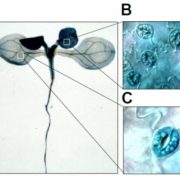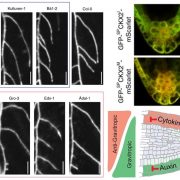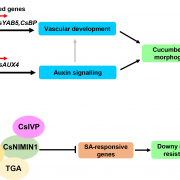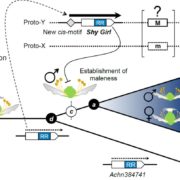Volatile communication in plants relies on a KAI2-mediated signaling pathway
 While it is recognized that plant communication, both within and between plants, can be achieved through emission and perception of volatile organic compounds (VOCs), it is unclear exactly how these signals are perceived and transmitted. Stirling et al. tease apart the components of within-plant VOC communication using the clever model system of pistil development in Petunia hybrida and a set of genetic and biochemical experiments. The authors show that changes in pistil width and length are dependent on emission of the VOC (-)-germacrene-D from the flower tube, and that this signal is perceived by the receptor karrikin insensitive2ia (KAI2ia), so that defects in either of these components prevent normal pistil development. KAI2ia is a homologue of karrikin insensitive2 (KIA2), previously identified as a receptor for volatile karrikins produced during fires. KIA2 interacts with MAX1 to degrade transcriptional repressors and activate fire-related responses. The authors show that KAI2ia acts through a similar mechanism. Many plants synthesise (-)-germacrene-D and receptors for this VOC are found in some insect pollinators, suggesting KAI2-like receptors may also have other roles such as in plant-insect communication. (Summary by Alicia Quinn @AliciaQuinnSci) Science 10.1126/science.adl4685
While it is recognized that plant communication, both within and between plants, can be achieved through emission and perception of volatile organic compounds (VOCs), it is unclear exactly how these signals are perceived and transmitted. Stirling et al. tease apart the components of within-plant VOC communication using the clever model system of pistil development in Petunia hybrida and a set of genetic and biochemical experiments. The authors show that changes in pistil width and length are dependent on emission of the VOC (-)-germacrene-D from the flower tube, and that this signal is perceived by the receptor karrikin insensitive2ia (KAI2ia), so that defects in either of these components prevent normal pistil development. KAI2ia is a homologue of karrikin insensitive2 (KIA2), previously identified as a receptor for volatile karrikins produced during fires. KIA2 interacts with MAX1 to degrade transcriptional repressors and activate fire-related responses. The authors show that KAI2ia acts through a similar mechanism. Many plants synthesise (-)-germacrene-D and receptors for this VOC are found in some insect pollinators, suggesting KAI2-like receptors may also have other roles such as in plant-insect communication. (Summary by Alicia Quinn @AliciaQuinnSci) Science 10.1126/science.adl4685









